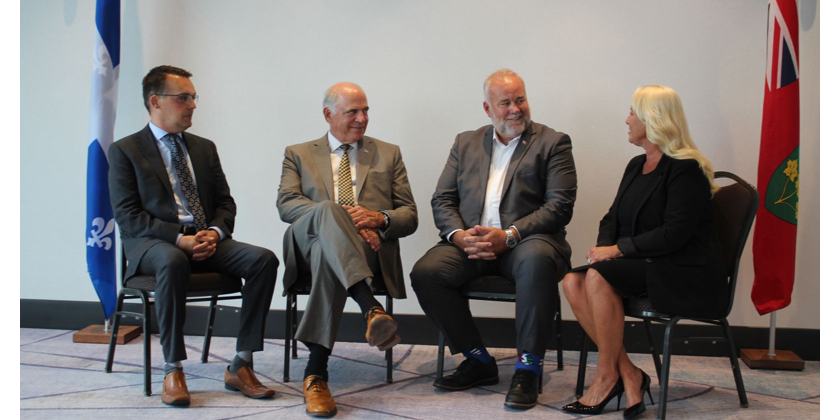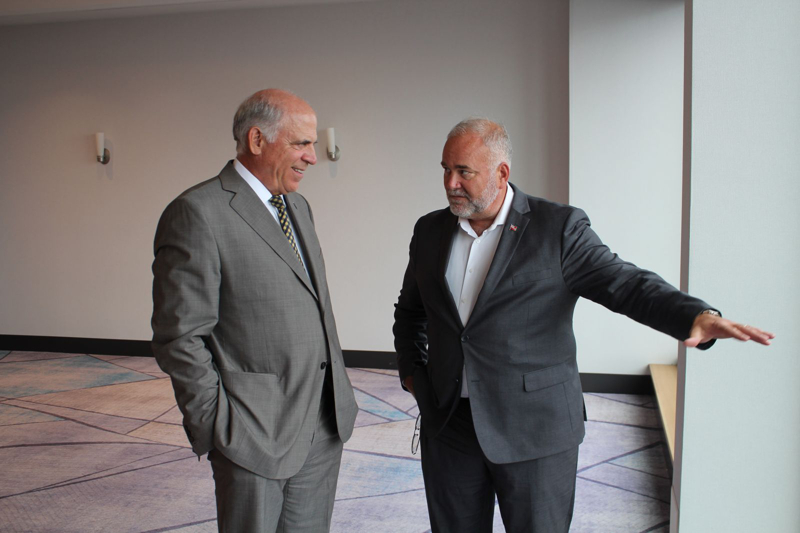IESO and Hydro-Quebec Enter New Electricity Trade Agreement

August 31, 2023
The governments of Ontario and Quebec are supporting a new 600 megawatt (MW) trade agreement between Ontario’s Independent Electricity System Operator (IESO) and Hydro-Québec that will optimize the use of existing electricity generation capacity in both provinces.
Today, during the Energy and Mines Ministers’ Conference, Ontario Minister of Energy Todd Smith and Quebec Minister of Economy, Innovation and Energy, Minister Responsible for Regional Economic Development and Minister Responsible for the Metropolis and the Montréal Region Pierre Fitzgibbon were joined by IESO Vice-President of Corporate Relations, Stakeholder Engagement and Innovation Carla Nell and Hydro-Québec Senior Director – Energy Transactions and Commercial Activities Simon Bergevin, who signed a Memorandum of Understanding as both parties work towards a final binding agreement.
This electricity trade agreement is possible because Ontario and Quebec have complementary seasonal peaks in electricity demand. Ontario’s peak demand occurs in the summer, driven mainly by air conditioning on hot days, and Quebec’s peak demand occurs in the winter, driven mainly by electric heating on cold days. As a result, both provinces have excess capacity during the other province’s electricity peak period that can be exchanged to reduce the need for new generation capacity.

“Our government’s open-for-business approach has resulted in unprecedented investments and job creation, from electric vehicles and battery manufacturing to critical minerals and green steel,” said Minister Smith. This agreement builds on our plan to Power Ontario’s Growth and will make best use of existing electricity generation capacity in each of our provinces as Ontario continues to build out our reliable, affordable and clean grid to power the next major international investment, the new homes we are building, and industries as they grow and electrify.”
“With the increase in energy demand, we must adopt more energy efficiency and intelligence measures in order to better manage peak electricity consumption,” said Minister Fitzgibbon. “The sharing agreement between Hydro-Québec and the IESO is a fine example of collaboration, which allows Québec and Ontario to meet the challenges of the energy transition in such a way as to decarbonize our economies.”
Quick Facts
- There are currently six interties between the Ontario and Québec transmission systems. The current interties between Québec and Ontario have a total combined capacity of approximately 2,775 MW.
- Ontario and Quebec both have one of the cleanest electricity grids in the world, with Quebec primarily supplied by hydroelectricity, and Ontario receiving a majority of its clean electricity supply from nuclear, hydroelectric and renewable generation.
- While both province’s meet their own energy needs, Ontario and Quebec both engage in electricity trading with neighbouring jurisdictions to optimize excess generation and keep costs down for ratepayers.
- Under the current Ontario-Quebec electricity trade agreement, the IESO can call on 500 MW of capacity from Quebec up until 2030. Ontario will maintain this option under the new agreement.
- Twelve months before the start of each contract year, the IESO and Hydro-Quebec may agree to increase the size of the capacity swap based on power availability.
Under this preliminary deal, the IESO and Hydro-Québec will carry out an annual capacity swap of 600 MW. The IESO will provide 600 MW to Hydro-Québec in the winter and Hydro-Québec will provide 600 MW to the IESO in the summer. Ontario will also have the opportunity to bank any amount of the 600 MW of summer capacity provided each year for use in any future summer period during the agreement, allowing the province to save capacity until it is required.
The term of this agreement is up to 10 years. The deal will be a straight swap of capacity with no payments required by either party, protecting ratepayers in both provinces. Subject to the terms of the final agreement, the new deal could start this upcoming winter season.
“The energy transition taking place underscores the importance of interprovincial collaboration,” said Lesley Gallinger, President and CEO of the IESO. “We are leveraging the complementary nature of our electricity systems to provide further flexibility in ensuring reliability at no additional cost to ratepayers.”
“To support Québec’s decarbonization and growth, the volume of electricity available must be significantly increased,” Michael Sabia, Hydro-Québec President and CEO, said. “That requires increased production and reduced consumption, but also agreements with our neighbours like the one announced today. Since peak demand occurs at different times in Ontario and Québec, we will work with our partners to better manage our network, for the benefit of all.”
The IESO and Hydro-Québec have also agreed to collaborate in exploring opportunities to both strengthen and increase the number of transmission connections between Ontario and Quebec. The two parties agreed a priority would be meeting increasing loads in the Abitibi and Timmins region, as well as exploring the potential for new capacity between Montreal and Toronto.









![Guide to the Canadian Electrical Code, Part 1[i] – A Road Map: Section 52 — Diagnostic imaging installations](https://electricalindustry.ca/wp-content/uploads/2022/11/Guide-CE-Code-2.png)






